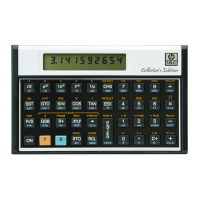172 Section 12: Calculating with Matrices
1. Store the elements of A in memory, in the form either of A
P
or of A
C
.
2. Recall the descriptor of the matrix representing A into the display.
3. If the elements of A were entered in the form A
C
, press ´ p to
transform A
C
into A
P
.
4. Press ´ > 2 to transform A
P
into Ã.
5. Press O < to designate the matrix representing A as the
result matrix.
6. Press ⁄ to calculate (Ã)
−1
.
7. Redimension A to have half the number of rows as indicated in the
display of its descriptor after the preceding step.
8. Store the elements of B in memory, in the form either of B
P
or of B
C
.
9. Recall the descriptor of the matrix representing A into the display.
10. Recall the descriptor of the matrix representing B into the display.
11. If the elements of B were entered in the form B
C
, press ´ p to
transform B
C
into B
P
.
12. Press ´ > 2 to transform B
P
into .
13. Designate the result matrix; it must not be the same matrix as
either of the other two.
14. Press *.
15. Press ´ > 4 to transpose the result matrix.
16. Press ´ > 2.
17. Redimension the result matrix to have half the number of rows as
indicated in the display of its descriptor after the preceding step.
18. Press l < to recall the descriptor of the result matrix.
19. Press ´ > 4 to calculate X
P
.
20. If you want the solution in the form X
C
, press | c.
A problem using this procedure is given in the HP 15c Advanced Functions
Handbook under Solving a Large System of Complex Equations.

